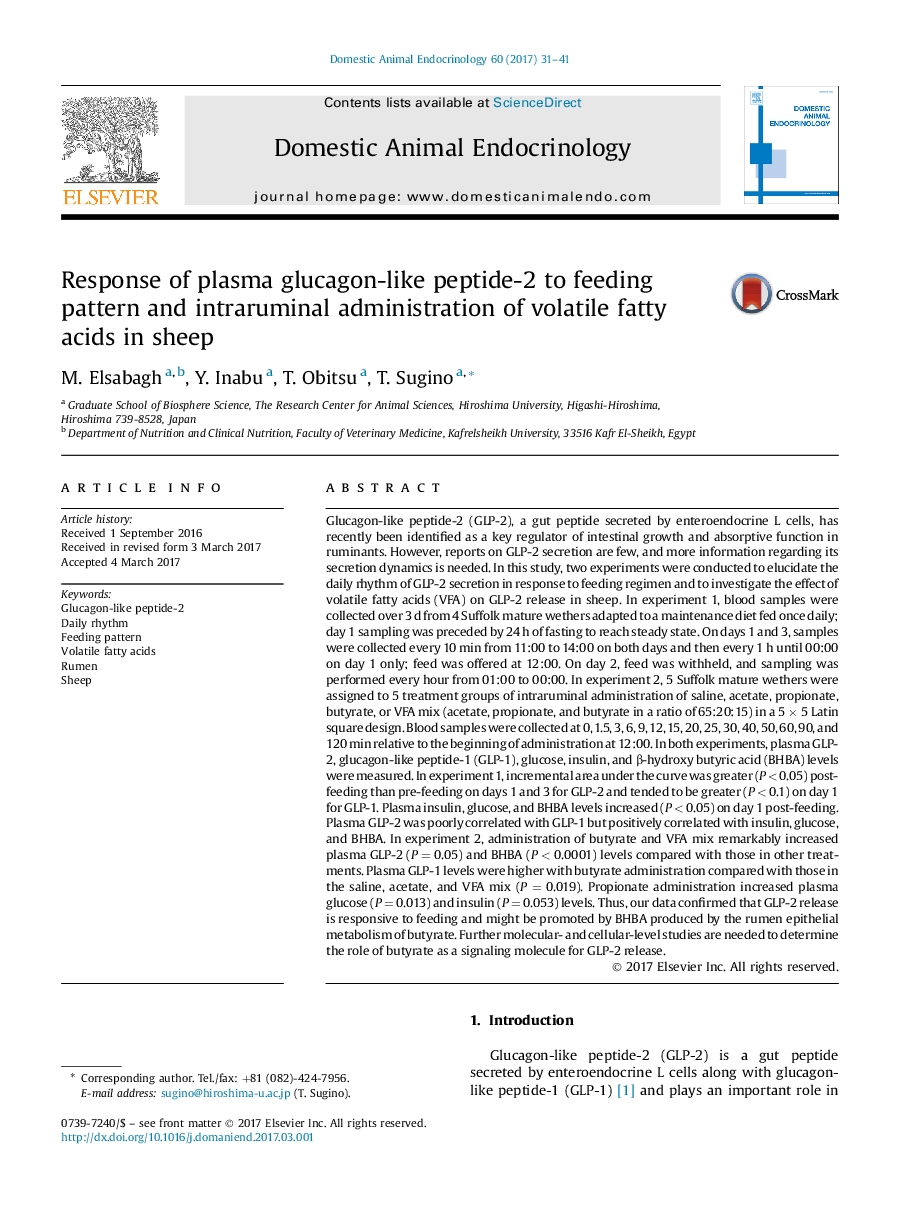| کد مقاله | کد نشریه | سال انتشار | مقاله انگلیسی | نسخه تمام متن |
|---|---|---|---|---|
| 5535378 | 1551499 | 2017 | 11 صفحه PDF | دانلود رایگان |
- Feed intake can positively regulate plasma glucagon-like peptide-2 (GLP-2) levels.
- Intraruminal supply of butyrate and volatile fatty acids mix enhances plasma GLP-2 levels.
- Intraruminal administration of acetate and propionate did not alter plasma GLP-2 concentrations.
- Butyric acid may be a potent GLP-2 secretagogue in ruminants.
- Normal secretion of GLP-2 can be regulated by functional feeding.
Glucagon-like peptide-2 (GLP-2), a gut peptide secreted by enteroendocrine L cells, has recently been identified as a key regulator of intestinal growth and absorptive function in ruminants. However, reports on GLP-2 secretion are few, and more information regarding its secretion dynamics is needed. In this study, two experiments were conducted to elucidate the daily rhythm of GLP-2 secretion in response to feeding regimen and to investigate the effect of volatile fatty acids (VFA) on GLP-2 release in sheep. In experiment 1, blood samples were collected over 3 d from 4 Suffolk mature wethers adapted to a maintenance diet fed once daily; day 1 sampling was preceded by 24 h of fasting to reach steady state. On days 1 and 3, samples were collected every 10 min from 11:00 to 14:00 on both days and then every 1 h until 00:00 on day 1 only; feed was offered at 12:00. On day 2, feed was withheld, and sampling was performed every hour from 01:00 to 00:00. In experiment 2, 5 Suffolk mature wethers were assigned to 5 treatment groups of intraruminal administration of saline, acetate, propionate, butyrate, or VFA mix (acetate, propionate, and butyrate in a ratio of 65:20:15) in a 5 à 5 Latin square design. Blood samples were collected at 0, 1.5, 3, 6, 9, 12, 15, 20, 25, 30, 40, 50, 60, 90, and 120 min relative to the beginning of administration at 12:00. In both experiments, plasma GLP-2, glucagon-like peptide-1 (GLP-1), glucose, insulin, and β-hydroxy butyric acid (BHBA) levels were measured. In experiment 1, incremental area under the curve was greater (P < 0.05) post-feeding than pre-feeding on days 1 and 3 for GLP-2 and tended to be greater (P < 0.1) on day 1 for GLP-1. Plasma insulin, glucose, and BHBA levels increased (P < 0.05) on day 1 post-feeding. Plasma GLP-2 was poorly correlated with GLP-1 but positively correlated with insulin, glucose, and BHBA. In experiment 2, administration of butyrate and VFA mix remarkably increased plasma GLP-2 (P = 0.05) and BHBA (P < 0.0001) levels compared with those in other treatments. Plasma GLP-1 levels were higher with butyrate administration compared with those in the saline, acetate, and VFA mix (P = 0.019). Propionate administration increased plasma glucose (P = 0.013) and insulin (P = 0.053) levels. Thus, our data confirmed that GLP-2 release is responsive to feeding and might be promoted by BHBA produced by the rumen epithelial metabolism of butyrate. Further molecular- and cellular-level studies are needed to determine the role of butyrate as a signaling molecule for GLP-2 release.
Journal: Domestic Animal Endocrinology - Volume 60, July 2017, Pages 31-41
